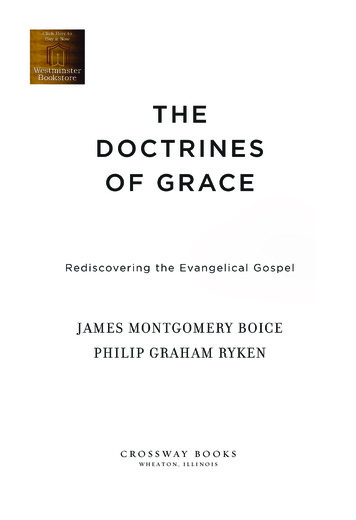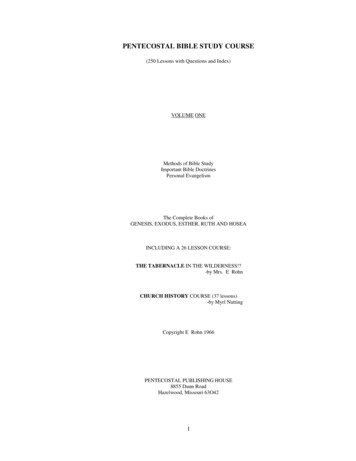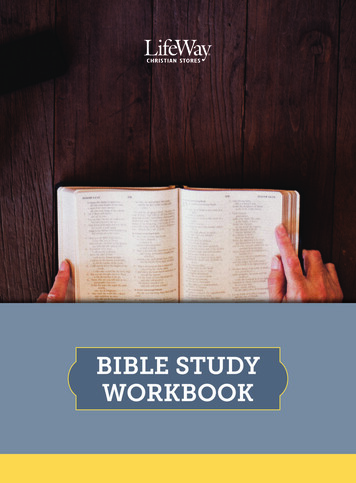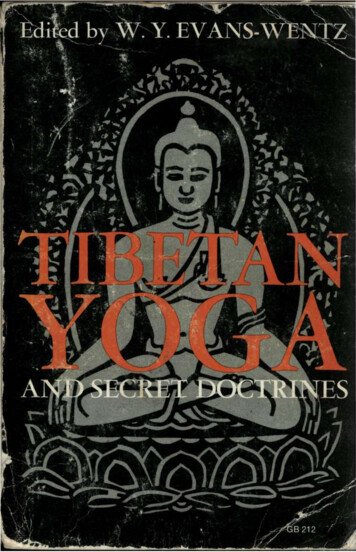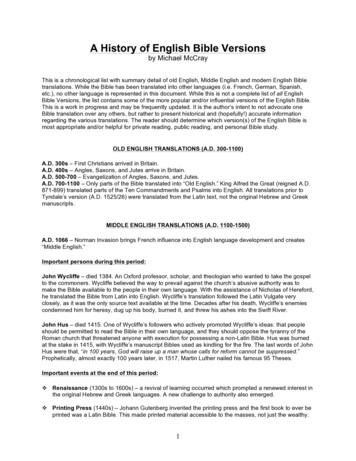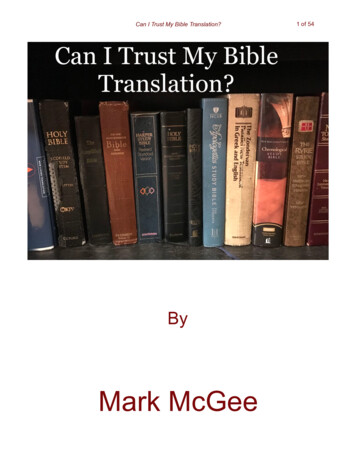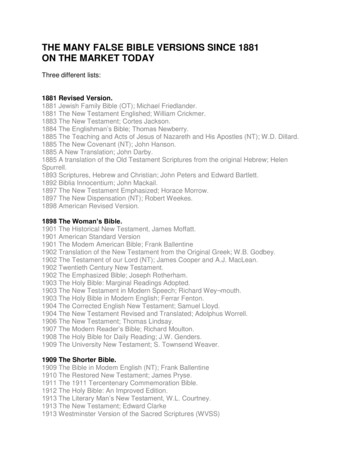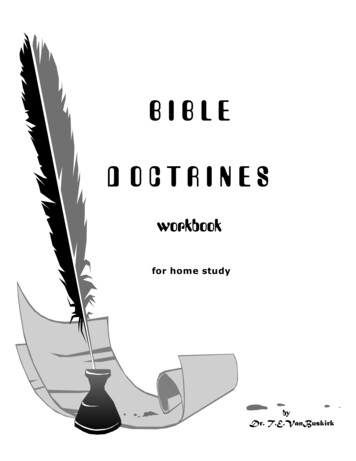
Transcription
BIBLED OCTRINESworkbookfor home studybyDr. T.E.VanBuskirk
BIBLEDOCTRINESfor home studyis a workbook intended to be used in a 2 - 3 quartersBible Doctrines class. The required text is“Great Doctrines of the Bible,” by Evans.This workbook is copyrighted and maynot be reproduced in any form withoutwritten permission from the author. 1998 & 2005 by Dr. T.E.VanBuskirkFor information on this workbook and other textsand workbooks by Dr. VanBuskirk, contact:Salt Lake Baptist College3769 W. 4700 S.Taylorsville, UT 84118phone: (801) 964-0763e-mail: docvbk@saltlakebaptistcollege.org
CONTENTSPRELUDE . . . . . . . . . . . . . . . . . . . . . . . . . . . . . . . . . . . . . . . . . . . . . . . . . . . . . .iiiINTRODUCTION . . . . . . . . . . . . . . . . . . . . . . . . . . . . . . . . . . . . . . . . . . . . . . . .Requirements for this class- . . . . . . . . . . . . . . . . . . . . . . . . . . . . . . . .2Grading breakdown . . . . . . . . . . . . . . . . . . . . . . . . . . . . . . . . . . . .31BIBLIOLOGY . . . . . . . . . . . . . . . . . . . . . . . . . . . . . . . . . . . . . . . . . . . . . . . . . .A Short Introduction to the Old and New Testaments . 8The Old Testament . . . . . . . . . . . . . . . . . . . . . . . . . . . . . . . . . 8The New Testament . . . . . . . . . . . . . . . . . . . . . . . . . . . . . . . .12Bibliology . . . . . . . . . . . . . . . . . . . . . . . . . . . . . . . . . . . . . . . . . . . . .15THEOLOGY . . . . . . . . . . . . . . . . . . . . . . . . . . . . . . . . . . . . . . . . . . . . . . . . . . .Introduction . . . . . . . . . . . . . . . . . . . . . . . . . . . . . . . . . . . . . . . . . . . 2iDEFINITION . . . . . . . . . . . . . . . . . . . . . . . . . . . . . . . . . . . . . . . . . . . . . . 22Theology proper . . . . . . . . . . . . . . . . . . . . . . . . . . . . . . . . . . . . . . 23TABLE OF ATTRIBUTES . . . . . . . . . . . . . . . . . . . . . . . . . . . . . . . . . . 26CHRISTOLOGY . . . . . . . . . . . . . . . . . . . . . . . . . . . . . . . . . . . . . . . . . . . . . . .INTRODUCTION . . . . . . . . . . . . . . . . . . . . . . . . . . . . . . . . . . . . . . . . . . . 30CHRISTOLOGY . . . . . . . . . . . . . . . . . . . . . . . . . . . . . . . . . . . . . . . . . . . 31PNEUMATOLOGY . . . . . . . . . . . . . . . . . . . . . . . . . . . . . . . . . . . . . . . . . . . . . .INTRODUCTION . . . . . . . . . . . . . . . . . . . . . . . . . . . . . . . . . . . . . . . . . . . 38PNEUMATOLOGY . . . . . . . . . . . . . . . . . . . . . . . . . . . . . . . . . . . . . . . . . 39ANTHROPOLOGY . . . . . . . . . . . . . . . . . . . . . . . . . . . . . . . . . . . . . . . . . . . . . .INTRODUCTION . . . . . . . . . . . . . . . . . . . . . . . . . . . . . . . . . . . . . . . . . . . 48ANTHROPOLOGY . . . . . . . . . . . . . . . . . . . . . . . . . . . . . . . . . . . . . . . . . 52SOTERIOLOGY . . . . . . . . . . . . . . . . . . . . . . . . . . . . . . . . . . . . . . . . . . . . . . . .INTRODUCTION . . . . . . . . . . . . . . . . . . . . . . . . . . . . . . . . . . . . . . . . . . . 58SOTERIOLOLOGY . . . . . . . . . . . . . . . . . . . . . . . . . . . . . . . . . . . . . . . . . 61ECCLESIOLOGY . . . . . . . . . . . . . . . . . . . . . . . . . . . . . . . . . . . . . . . . . . . . . . .INTRODUCTION . . . . . . . . . . . . . . . . . . . . . . . . . . . . . . . . . . . . . . . . . . . 73ECCLESIOLOLOGY . . . . . . . . . . . . . . . . . . . . . . . . . . . . . . . . . . . . . . . . 76ANGELOLOGY . . . . . . . . . . . . . . . . . . . . . . . . . . . . . . . . . . . . . . . . . . . . . . . .INTRODUCTION . . . . . . . . . . . . . . . . . . . . . . . . . . . . . . . . . . . . . . . . . . . 83ANGELOLOGY . . . . . . . . . . . . . . . . . . . . . . . . . . . . . . . . . . . . . . . . . . . . 83SATAN . . . . . . . . . . . . . . . . . . . . . . . . . . . . . . . . . . . . . . . . . . . . . . . . . . . . . .ESCHATOLOGY . . . . . . . . . . . . . . . . . . . . . . . . . . . . . . . . . . . . . . . . . . . . . . . .5ii.213038485873839195
PRELUDERo 6:17 But God be thanked, that ye were the servants of sin, but ye haveobeyed from the heart that form of which was delivered you.Eph 5:25-27 . even as Christ also loved the church, and gave himself for it;That he might sanctify and cleanse it with the washing of water by the word,That he might present it to himself a glorious church, not having spot, orwrinkle, or any such thing; but that it should be holy and without blemish.Memorize: II Tim 3:16-17, with proper punctuation.Instructions for workbook: Look up ALL scripture references. Blanks cannot be filled in.Definition of doctrines:Problem:1. What is taught as the beliefs of a church, nation, etc.2. What is taught- the teachings themselves.The churches of today are cold and indifferent to the cause of Christ.Why? Because of a lack of knowledge of the doctrines of the Word of God.This was foretold in the Scriptures.I Tim 4:1These doctrines must become part of your life; i.e., not just knowledge.In your heart- not just in your mind.EXHORTATIONMost of you are preparing for full time service. Some as Pastors; some as evangelists; someas Sunday School teachers; and some of you ladies are going to be pastor’s and worker’s wives.This means that many times you are going to be called upon to help your husband in more waysthan just by being his wife. That alone is a hard enough job, true; but, you may also have tohelp teach classes, counsel, lead ladies meetings, and fill various other positions, in which,under your husband’s leadership and authority, you will help him prepare those Christians thatGod entrusts to his care for the ministry. Some of you, at this time, may not be planning onbeing in the ministry; but, I will share something with you from my 18 yrs. in the ministry- Godhas a habit of taking people one step at a time because they are not yet ready for His completerevealed will in their lives. Being here may be that first step. Don’t be surprised, God may beleading you into some type of local church ministry. You have taken the first step and yieldedto His will by being here in this class, this is just the beginning of the trip. You have shownyour willingness to go where He wants you to go and do what He wants you to do; and I findthat all of God’s many roads for willing Christians lead in just one direction- some type ofiii.
ministry for the propagation of the Gospel and work of Jesus Christ in and through the localNew Testament Church. Therefore, all of the students in this room, in one way or another, mustlearn the basic doctrines of the Bible in order to carry out what ever ministries that God givesto you. Some of you will serve as pastors and teachers; and some of you ladies will serve asteachers as well as helpers to your husbands in other ways; but, for each of you, in one placeof service or another, it all ultimately comes down to one thing- you MUST be prepared to carryout God’s commands!Relevant scripturesII Tim 2:15 to shew thyself approved unto God, a workman thatneedeth not to be ashamed, rightly the word of truth.Eph 4:11-12 And he gave some, apostles; and some, prophets; and some, evangelists;and some, pastors and teachers; For the of the saints, forthe work of the ministry, for the edifying of the body of Christ:I Tim 4:13 Till I come, give attendance to reading, to exhortation, to .I Tim 5:17 Let the elders that rule well be counted worthy of double honour,especially they who labour in the word and .II Tim 4:1-4 I charge [thee] therefore before God, and the Lord Jesus Christ, whoshall judge the quick and the dead at his appearing and his kingdom;Preach the word; be instant in season, out of season; reprove, rebuke,exhort with all longsuffering and doctrine. For the time will come whenthey will sound ; but after their own lustsshall they heap to themselves teachers, having itching ears; And they shallturn away [their] ears from the truth, and shall be turned unto fables.Titus 1:9 Holding fast the faithful word as he hath been taught, that he may beable by sound both to exhort and to convince the gainsayers.Titus 2:7-8 In all things shewing thyself a pattern of good works: in[shewing] uncorruptness, gravity, sincerity, Sound speech, that cannot becondemned; that he that is of the contrary part may be ashamed, havingno evil thing to say of you.Every Christian should know the various doctrines of God’s Word. They will not learn themunless God uses someone to teach them. Nothing that God gives you is to be hoarded;including what you will learn in this and other classes here at the college. Learn it well andthen God can use you to teach others. Learn it poorly and the devil will use you to confuseothers. The choice is up to you. You are here because God has arranged things in your life toget you here. He has given you the desire to be here and led you here; therefore, you mustmake this time of preparation, being in school and doing your best while you are here, a highpriority in your life right now.Since God wants you here, and you have yielded to the will of God by being here, then don’tlet the devil defeat you and/or discourage you by trying to get you to quit or flake off while youiv.
are here. Also, don’t let other students or others in your sphere of acquaintances or familyinfluence you in any negative way. Keep your mind stayed on God and the job He has givenyou to carry out at this time- furthering your understanding of His Word by being here for allof the classes, and doing the required work while you are here. Seek to please God in allmatters.Gal 1:10II Tim 2:15Now! On to our study of God’s Word and its various doctrines.v.
INTRODUCTIONOne of the greatest needs for students of God’s Word today is the same as it was during thetime that our Lord and Saviour walked the face of this earth; a basic understanding of thevarious doctrines of the Bible and where to find the texts supporting those doctrines in theScriptures themselves. Of course now we have material to help us have a better understandingof those doctrines than the disciples did during those first years of the church because we havethe completed New Testament as well as the Old Testament. T he two most importantnecessities for a basic understanding of Bible doctrines is to have the Holy Spirit to guide usand to have the preserved Word of God in which to reference what God teaches on a nyparticular subject. The first, the Holy Spirit, we receive at the moment of our Salvation, thesecond, the preserved Word of God, we have (in English) in only the King James Bible. If wedo not have these two for a solid foundation, then to try to build a basic understanding of Bibledoctrines is but an exercise in futility.Ps 11:3 If the be destroyed, what can the righteous do?Assuming you have the Holy Spirit, and you do if you are saved, (and if you aren’t then getthat way right now or you CANNOT understand the Bible [I Cor 2:14; Jn 16:13] no matter howgood of a scholar you are,) then the only other thing you need is the preserved Word of Godwhich is our only foundation for truth, practice, service, and guidance. Without it we have nomoorings to hold us in place and we will surely be cast adrift in a Sargasso of lies and halftruths scattered with the broken hulls of doctrines wreaked upon the rocks of heresy. Nomatter what, or who else tries to teach you, even if it be a voice from heaven itself, the Bibleis a more sure mooring.II Pet 1:18-20 And this voice which came from heaven we heard, whenwe were with him in the holy mount. We have alsoprophecy; whereunto ye do well that ye take heed,as unto a light that shineth in a dark place, until the day dawn, and theday star arise in your hearts: Knowing this first, that no prophecy ofis of any private interpretationPs 119:89 , O LORD, thy word is settled in heaven.Ps 119:105 Thy word [is] a unto my feet, and a light unto my .Ps 119:140 Thy word [is] very pure: therefore thy servant loveth it.Ps 119:160 Thy word [is] true [from] the : and every oneof thy righteous judgments [endureth] .John 17:17 Sanctify them through thy truth: thy word is truth.Settle once and forever what foundation you will use on which to build your basic understanding of the doctrines of God. You must choose which Bible you will use, for you cannotuse more than one, because they all teach something different. This workbook is based uponthe King James Bible which is incontestably the only English translation today that is true tothe vast majority of the preserved texts from the original languages.(See, “The Doctrinal Chaos of the Translations,” also by Dr. VanBuskirk.)BIBLE DOCTRINES Workbook1
Textbook - required readingThe textbook for this class will be “Great Doctrines of the Bible,” by William Evans.We will follow Dr. Evan’s textbook closely but we must keep in mind that he comes froma varied religious background, including: attending colleges and seminaries of various religiousgroups, serving in several Presbyterian pastorates, and serving as director of the department ofBible at Moody Bible Institute for fifteen years as well as serving as the dean of the BibleInstitute of Los Angeles, another liberal Bible institution, for three years following his tenureat Moody. Because of his background and education, ranging from Lutheran to Presbyterian,he has a tendency to promote several views that are contrary to the Bible and, therefore, theyalso are contrary to traditional Independent Baptist views. We will attempt to correct theseerrors as we come to them in the course of our study; but, we will do so only when it can beshown, from the KJV (God’s preserved Word) that they are contrary to the Bible.The arrangement of the workbookIn this workbook we will cover ten major doctrines of God’s Word, and, time permitting, wewill cover several other doctrines as we ll. In t he text, “Great Doctrines of t he Bible,”(hereafter to be called, “GDOB,”) released in 1912, Dr. Evans expounded on the ten doctrinesthat we will cover in depth. Later, Dr Coder expanded the book with eighty additional entries,several of which we will try to touch upon. In addition to GDOB, we will use several othersources. These are listed in the Bibliography. There is also a Reference section at the end ofthe workbook which lists all of the so urces referenced and, wh erever possible, each suchreference will be numbered for convenience, in the workbook text, to facilitate location of thematerial cited. Whenever a reference is indicated in the workbook by a number only withouta letter, such as “(9),” that means that the references was used as a source book for general ormultiple references, such as in a dictionary, concordance, or lexicon, etc.We will not follow the exact order in which the doctrines are presented by Dr. Evans. Wewill begin with the foundational doctrine upon which all of the others rests, Bibliology- TheDoctrine of the Scriptures. After that, we will follow the order used by Dr. Evans.REQUIREMENTS FOR THIS CLASS - located on the class webpage, “The Church.”BIBLE DOCTRINES Workbook2
SUGGESTED READING:The following books are not required reading in order to pass this class. However, thepurpose and aim of every teacher is to take the student as far as is possible within theknowledge possessed by the teacher; and, in addition to that journey within the classroom, towhet the appetite of the student to go much much further. The mark of a successful teacher iswhen the student, after leaving the class, goes on to add to the body of knowledge presentedby that teacher. The heart of a true teacher is to see his or her students go on to eventually outdo the teacher in his or her accomplishments. If the teacher is successful in instilling thefoundation in the student, then they do not have to worry about that student getting off intoerror. It is always possible of course; (look at the problems in the church at Ephesus and thenlook at the caliber of the original pastors/teachers during the foundational period of it) but, ifthe teacher sets a sure foundation of knowledge under the student then the teacher can beassured that any later heretical leanings of that student are by the choice of the student and notbecause of a lack of a sure foundational structure at the hands of the original teacher.Therefore, the following books are suggested reading and will be helpful to the student inexpanding their knowledge of the Scriptures beyond the scope of what will be imparted in thisclass. This class is intended to give only a basic knowledge of Bible Doctrines; to, as it were,build the basic foundation upon which you can then continue on and build a life of study. Donot stop here, for if you stop learning you will stagnate. Be ever learning while the Lord keepsyou here on this earth and be ever looking for the Lord to come and take you from this earth.An old warrior of the faith once said,”Live your life as if the Lord were coming back today;but plan your life as if He were not going to come back within your lifetime.” These books willhelp you prepare for that possible future. As I said before, they will take you beyond the scopeof our current study and help fulfil my desire for you to be ever growing and out do my limitedaccomplishments many times over. I was saved in my middle years and thus I have but a fewmore years, maybe a couple of decades if the Lord blesses, to give to the work of my Lord andSaviour; but most of you have many more years than that to give and I can continue servingHim, through you, even after I am gone.I do not agree with everything nor every stance taken by the authors in the following list ofbooks. But then I have not found an author yet that I agree with totally. The problem we haveis that none of the common doctrinal textbooks were written by Independent Baptists; therefore,we are forced to follow the advice of Dr. Warneke: “It’s just like eating chicken; you eat themeat and spit out the bones.” When Independent Baptists start realizing that we need somebooks written by Independent Baptists putting forth the systematic beliefs historically peculiarto Independent Baptist, (that means of course viewpoints that are unswervingly biblical) then,and only then, we can have a meal of all meat and no bones. Maybe one of you will delve intothat field. But, until then we will have to make do with what we have and judge what is meatand what is bones by whether the viewpoints expressed agree with or do not agree with theBible.BIBLE DOCTRINES Workbook3
Enough said. Here is the list:Outline Studies in Christian Doctrine pub. 1926Dr. George P. PardingtonChurch background- Missionary AllianceChristian Theology 1925Dr. Emery H. Bancroftnd2 Revised Edition 1961, edited by Dr. Ronald B. MayersChurch background- Baptist, non-IndependentEnjoy the class, and let’s have a good time around God’s Word and the Lord Jesus Christ!Dr. VBKBIBLE DOCTRINES Workbook4
BIBLIOLOGYThe Doctrine of the ScripturesIntroductionAlthough Evans treats the subject of the Scripures eighth in order in the textbook (GDOB)we will, as I said earlier, place it first in the order of our studies. The reason for this is that theScriptures, and the study of them (Bibliology) is the foundation upon which rests the systematicstudy of all that we believe in every doctrine of the Bible. And, in addition, the combined bodyof the scriptures is the schoolmaster that points every man- from the Jew of ancient history tothe man, Jew or Gentile, of today- directly to Christ for Salvation, without which Salvation NOMAN can understand the Scriptures. Therefore, my reasons for starting with Bibliology arereally circular ones.A. To understand the doctrines revealed in the Scriptures one must be able to understand theScriptures.B. To understand the Scriptures one MUST possess the Holy Spirit who will teach them toyou through enlightenment of your mind so you can understand them.C. In order to possess the Holy Spirit you must be a Saved individual.D. In order to be a Saved individual you must possess Christ.E. The Scriptures themselves are what leads men to Christ.F. Since all of the above, “A.B.C.D.E.,” lead to the one common denominator, theScriptures, then we must start with that common denominator.G. And that brings us full circle- back to the Scriptures. So that is where we will start.BIBLE DOCTRINES Workbook5
Evans’s treatment of Bibliology (The Doctrine of the Scriptures) is a very basic one. It hasonly two main headings:NOTE: Homework- What are the two main headings underthe Doctrine of the Scriptures? (Bibliology)I.II.INSTRUCTIONS: Wherever the abbreviation “Refs.” is found, write in the referencesfrom the textbook. Also, read those references in your Bible.THE BIBLE - ITS NAMES AND TITLES1. The Bible.(Refs.2. The Old and New Testaments.(Refs.3. The Scripture.(Refs.The Scriptures.(Refs.4. The Word of God.(Refs.)))))There are several other names/titles for the Word of God that are not listed in GDOB:5. The Law- a generic term for the Old Testament.There are basically three subdivisions within the Jewish Old TestamentThe Law, The Prophets, and Writings.a. The first Jewish Bible consisted of the five books of Moses and wasdesignated: “the Law,” which is also known as the Pentateuch.b. Later, “the Prophets” was added.c. The final division was called “the Writings.”In the New Testament, references to “The Law,” are sometimes obviously referencesto the Pentateuch, the five books of Moses. (Mt 12:5; 22:36; et al) Other times theJewish reverence for the Law comes to the forefront and the whole of the OldTestament is referred to as The Law. This is apparent in NT use of the term “the Law”when referring to the Psalms (Jn 10:34; 12:34; 15:25) and Isaiah (I Cor 14:21)6. The Law and the Prophets- sometimes the combined term The Law and the Prophetsis used to designate the OT. (Mt 5:17; 7:12; et al)BIBLE DOCTRINES Workbook6
Only one time in the New Testament is a literal three-fold grouping used for the OldTestament.Lk 24:44 And he said unto them, These [are] the words which I spake untoyou, while I was yet with you, that all things must be fulfilled, which werewritten in the of Moses, and [in] the , and [in] the, concerning me.In context Christ was talking about Messianic prophecies and allusions from the OldTestament. That is obviously why He included the Psalms, since they are so clearlyspecific in their Messianic prophecies.For whatever reason the groupings were given as the Law, Prophets and Psalms, itis still an obvious allusion to the three-fold grouping of the Old Testament that was sofamiliar to the Jewsof Jesus’s day. (The Psalms was the first book of the Hagiographa,the Writings, which were known to the Jews as the Kethubhim.)NOTE: HomeworkNOTE: These will all be test questions.How many books in the KJV Old Testament?How many books in the KJV New Testament?What does the word “Testament” mean?What are 3 names for the Bible, other than “The Bible?”The KJV Old Testament is [exactly the same as different than] the Jewish Bible incontent?[------- CIRCLE ONE ANSWER-------]BIBLE DOCTRINES Workbook7
A Short Introduction to the Old and New TestamentsWe do not have the time for a complete introduction to the Old and New Testaments; thatwould take another entire quarter, at least. There are many books that thoroughly treat thesubject; we however, because of time and space constraints, will confine ourselves to a verybrief introductory study. (For a list of the books, see the bibliography. Specifically #’s 2, 6,7. Also see: A Survey of the New Testament by Robert H. Gundry, from Zondervan PublishingHouse. Bear in mind however that I do not espouse everything you will find in any of thosebooks; however, they are useful for facts & figures.)The Bible used by us today contains the exactOld Testament of the ancient Jewish Bibles.Although the divisions and arrangement of thebooks is different, no new material was added.Therefore, our Old Testament is essentially theBible of the ancient Jews.Our Old Testament is divided into 39 books.The Jews originally used a 22 boo k arrangement and later a 24 book arrangement was used.Since 1 517, however, the He brew Bible hasused a 39 b ook arrangement like our OldTestament; but, the order of the books and thethree-fold division follows that of the ancienttexts. Genesis (bereshith) opens their Bible, as in our OT, but II Chronicles closes theirs ratherthan Malachi as in ours.THEOLDTESTAMENTThere is evidence that the most ancient of the Hebrew Scriptures were divided into 22 books.This is supported by the Jewish priest Josephus, a Pharisee, who wrote during the second halfof the first century AD. The 22 book arrangement was also mentioned by Origen (185-254),who first brought attention to the fact that 22 was also the number of letters in the Hebrewalphabet. The 22 book arrangement was also mentioned by Athanasius (4th century), Gregoryof Nanzianus (4th century), Hilary of Poitiers (4th century), Epiphanius (4th century), and, later,by Jerome (4th-5th centuries). It is obvious that many from the first through the fifth centuriesbelieved the 22 book arrangement was the most ancient one.The difference between the 22 and 24 book traditions concerned the joining of the books ofRuth and Judges, and Lamentations and Jeremiah. In the 22 book tradition, these were joinedto become two books; Ruth-Judges and Lamentations-Jeremiah. This would have put Ruth andLamentations in the second division, the Prophets, instead of the third, the Writings. Theirsegmentation probably took place after the second century AD, at which time they were transferred to the Writings, probably for liturgical reasons concerning their use at certain feasts.BIBLE DOCTRINES Workbook8
Facts about and reasons for the three-fold division of the Hebrew Scriptures (2a)The Law- is identical with our Pentateuch.The Prophets- were written by men who had both the gift and the office of Prophet.The Writings- were written by men who had the gift but NOT the office of Prophet.The Rolls- Five of the books included in the Writings were each written on a separatescroll to facilitate their being read at certain Hebrew feasts.Reading of the rolls at the overPentecostTabernaclesPurimAnniversary of the destruction of JerusalemHistory of the three-fold division and the canonHebrew tradition holds that the book divisions and canon were settled at The GreatAssembly, which was a council gathered during the first generation following the building ofthe Second Temple (520 BC). Tradition holds that both Ezra and Nehemiah were included inthis Great Assembly. From that time until the institution of the Sanhedrin in 300 BC, thisassembly ruled as the governing body for the returned Jews. (2a)From that meeting came the canon and the three-fold division of it accepted by the majorityof Jews at that time. That acceptance has continued down to the present day.Preservation and standardization of the Jewish Scriptures (2b)The Earliest Period: From the autographs to 135 A.D.The original guardians and transcribers were a special guild of sopherim (scribes) whosebusiness was the meticulous reproduction of the sacred texts for handing on from generationto generation. T hese sopherim existed at least from the time of Ezra (ca 400 B.C. ) andprobably from the time of Moses. These scribes viewed the texts as the very words of God.Therefore, the texts were held unchangeable not just for scholarly reasons and in pursuit oftextual purity in and for itself but in reverential awe. With religious zealousness the books wereprotected, preserved, and transcribed, in a painstakingly meticulous manner seen by no othergroup of texts in history outside of the Greek texts of the New Testament.At the Jew ish Council at Jam nia, in 90 A. D., the c anon of the Jewish Scriptures w asofficially closed. With Bar-Cocheba’s rebellion (A.D. 132-135) the last of the Judeo-Christians(Nazarenes) were expelled from the Synagogue. In the ensuing arguments, Jews went to theirHoly Writings in order to answer the Christians, which by and large used the Greek Septuagint.This caused even more care and interest (if that were possible) in the very letter of the JewishBible. One Jewish Rabbi, R. Akiba (died 132 A.D.) sought “hidden meaning in particles,peculiarities of spelling and other minutiae of the text.”(op cit) This type of minute scrutiny of thetext, which was originally the domain and a peculiarity of the Jewish people, was now handedon to a second group, the Christians who also used the same texts as a prelude to their soon tobe collated and challenged New Testament texts.BIBLE DOCTRINES Workbook9
TheTalmudic Period: 135-500 A.D.The next group to preserve and standardize the Jewish Scriptures were the rabbis during theTalmudic period. (135-500 A.D.) These scholars introduced no changes in the content of thetexts but did introduce certain reading aids, marks, vowels, accents, spelling variations, andmodernization of place names. These were added to facilitate more accurate reading andunderstanding of the texts. Although word divisions in the text (the autographs were writtenin one long unbroken series of letters with no vowels or punctuation) occurred sometimebetween 150 and 100 B.C., verse divisions did not occur until sometime later. They were firstmentioned in the Mishnah in A.D. 200, but varied widely in Palestine and Babylonia for manycenturies.During this period certain obscenities and indelicate language were replaced with euphemisms; such as the term for the boils associated with sexual perversions which was replaced withthe term “emerods.” Also the names of heathen gods were eliminated or changed because ofthe horror with which the synagogue regarded those objects of idolatry.The Massoretic Period:
B I B L E D O C T R I N E S for home study is a workbook intended to be used in a 2 - 3 quarters Bible Doctrines class. The required text is “

